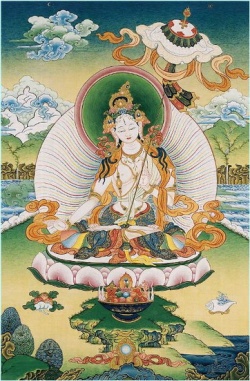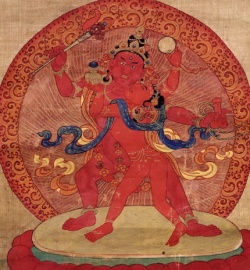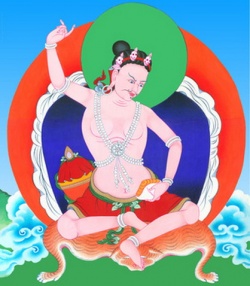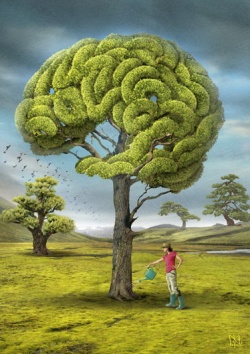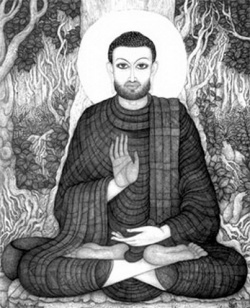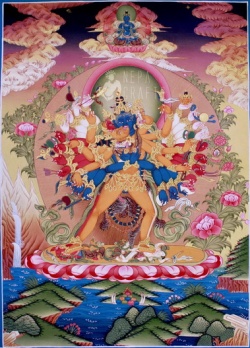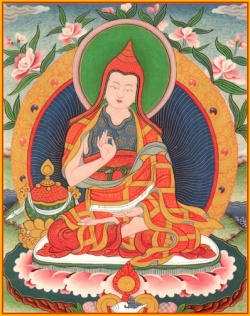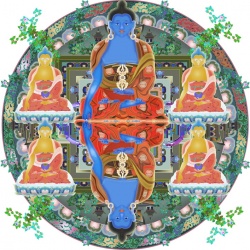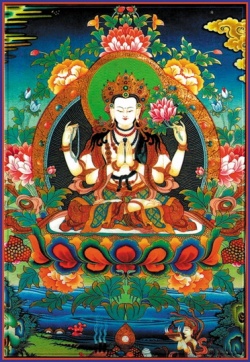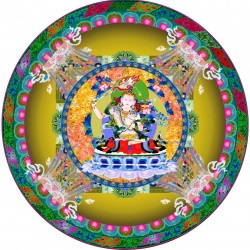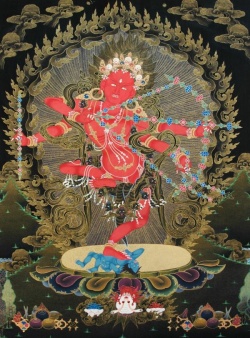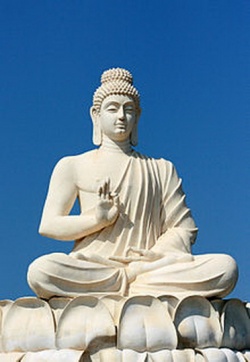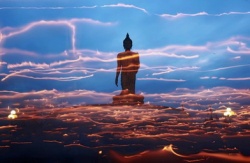The Dharma Flower Sutra seen through the Oral Transmission of Nichiren Daishōnin:The Eighteenth Chapter on the Joy of the following Meritorious Virtues of Practice
The Dharma Flower Sutra
seen through the Oral Transmission of
Nichiren Daishōnin
The first important point, concerning the Eighteenth Chapter on the Joy of the following Meritorious Virtues of Practice involved with the Sutra on the White Lotus Flower-like Mechanism of the Interdependence of Cause, Concomitancy and Effect Permeating the Utterness of the Dharma.
The Oral Transmission on the Meaning of the Dharma Flower Sutra (Ongi Kuden) says that the verb “to follow” involves complying with the three all-embracing esoteric Dharmas, both in practice and the essential elements of holding faith in the Fundamental Object of Veneration (gohonzon) (in the sense that it is a mandala that represents the totality of the Buddha wisdom), the place where it is enshrined, as well as reciting the theme and title (daimoku) Nam Myōhō Renge Kyō (thereby opening up our inherent Buddha nature, with our persons just as they are).
The word “joy” means that we ourselves as well as others jointly experience this joy. The expression “of practice” implies faithfully understanding the original archetypal state in practical terms that is the concept in the depth of our minds, which in the India of Shākyamuni was expressed as the uncountable grains of dust that would be left over should someone grind into powder five hundred universes from their inception to their termination. This concept is perpetuity itself, which we experience in our daily lives as the ever-present infinite in time (kuon ganjo).
The “essential elements” are the revelation of the original terrain of all enlightenment (which is the teaching derived from the external events of the Buddha Shākyamuni’s life and work (shakumon) that was first revealed in the Second Chapter on Expedient Means of the Dharma Flower Sutra as the ten ways dharmas make themselves present to any of our six organs of sense – eyes, ears, nose, tongue, body, and mind (i.e., jūnyoze) – which is the theoretical concept of each single instant of mental activity containing three thousand existential spaces). Ultimately, this means that we must faithfully comply with the inner realisation of the Chapter on the Lifespan of the Tathāgata (which is that life within us can never be destroyed).
Naturally holding to these concepts with faith, then, both we ourselves as well as other people will enjoy the happiness of their wisdom, discernment, compassion, and loving-kindness. As a result, Nichiren and those that follow him reverently recite Nam Myōhō Renge Kyō which means to devote our lives to and found them on (Nam(u)) the Utterness of the Dharma (Myōhō) (entirety of existence) permeated by the underlying white lotus flower-like mechanism of the interdependence of cause, concomitancy and effect (Renge) in its whereabouts of the ten (psychological) realms of dharmas (Kyō), and in this way are filled with the joy that they will decidedly open up their awareness of the threefold entity of the Buddhahood that has eternally existed in the past and will exist in the perpetuity of the future (in their lives).
Therefore, this word “follow” applies to the Dharma, and the word “joy” is applicable to the joy of the person in question. The person is the archaic Buddha that is the depth of the indestructibility of the life in our minds, which in the India of Shākyamuni was expressed as the uncountable grains of dust that would be left over should someone grind intyo powder five hundred universes from their inception to their termination. This concept is perpetuity itself, which we experience in our daily lives as the ever-present infinite in time (kuon ganjo).
The Dharma of this archaic Shākyamuni is the Nam Myōhō Renge Kyō in the Chapter on the Lifespan of the Tathāgata, which means to devote our lives to and found them on (Nam(u)) the Utterness of the Dharma (Myōhō) (entirety of existence) permeated by the underlying white lotus flower-like mechanism of the interdependence of cause, concomitancy and effect (Renge) in its whereabouts of the ten (psychological) realms of dharmas (Kyō).
To comply joyfully with this basic concept is the resulting joy of compliance. Generally speaking, the verb “to comply” is another way of expressing a mind of faith. It is said that only with a mind of faith is one able to observe with devotion. Therefore, in the second fascicle (scroll) of this sutra it says that it is because of following this sutra and not on account of one’s personal wisdom.
At the time, Maitreya (Miroku), the completely evolved bodhisattva who had refused his own extinction into nirvana for the sake of the Buddha enlightenment of all sentient beings (bosatsu makasatsu, bodhisattva mahāsattva), addressed the World Honoured One, saying: “World Honoured One, if there are believing and convinced men and women who reverently listen to this Dharma Flower Sutra (Hokke-kyō) and are elated as a result, how much good fortune will they get?”
Then he expressed himself in the terms of a metric hymn.
After the World Honoured One
has passed over
to the extinction of nirvana,
for those who listen to this sutra
and are able to rejoice over it
as a consequence,
how much good fortune should they attain?
Then the Buddha addressed Maitreya (Miroku), the completely evolved bodhisattva who had refused his own extinction into nirvana for the sake of the Buddha enlightenment of all sentient beings (bosatsu makasatsu, bodhisattva mahāsattva), saying: O Invincible One, after the extinction of the Tathāgata into nirvana, if there are monks, nuns, or lay believers both male and female, or other intellectuals, who, on hearing this sutra, as a result, are full of joy and leave the assembly to go elsewhere – whether it be the residential quarters of monks or deserted places in the wilds, or a city or a market town, a hamlet, or way out into the country – then, just as they have heard this sutra, they explain it to their fathers, their mothers, to their other relatives, their close friends and acquaintances, then, after all these people have heard this sutra and are filled with the resulting joy (at the indestructibility and perpetuity of life, even though we go through the various intermediate phases between dying and being reborn again), they also go off into other directions to propagate this sutra to others until they have expounded it to the fiftieth person, this, O Invincible One, as to the meritorious virtues and the consequential joy of the fiftieth convinced and believing man or woman, I will now tell you about; so listen carefully.
Among all the beings that continually revolve in the six realms of dharmas (i.e., the hells, hungry ghosts, animality, giants or shura (ashura), human beings or deva (ecstasy)) that inhabit the four hundred myriads of myriads of myriads of existential dimensions – whether they are born from eggs, the womb, dampness, or are born by supernatural transformation, or whether they are endowed with a form or without shape, or whether they have conscious notions, or are devoid of conscious thought, or with no existence of conscious thought, or have completely no awareness of their own existence whatsoever, or whether they have no feet, two feet, or many feet – there was one person who sought after happiness.
According to whatever item of pleasure any of those beings wished for, he procured all that was necessary for their pleasure. To each one of those beings, he gave a whole continent of all its gold, silver, lapis lazuli, mother-of-pearl, agate, coral, and amber, as well as elephants, horses, carts, chariots, palaces, and pavilions made of the seven precious materials (gold, silver, lapis lazuli, crystal, agate, ruby, cornelian).
Then the thought came into the mind of this great donor who had given so much charity over a full period of eighty years: I have already given sentient beings the things that would please them according to their wishes. Now they are old and feeble. Their hair is white, and their faces are wrinkled. It will not be long before they die. I really must teach and guide them into the Buddha teaching.
He then assembled together all those sentient beings, to whom he explained the Dharma that converted them. He revealed, taught, and benefitted them, as well as giving them joy (through the content of the Chapter on the Lifespan of the Tathāgata), so that they all simultaneously either entered onto the path of ascetic living, or as people who need to return to this world for only one more lifetime before attaining nirvana, or as people who will not return to this dimension, or even as those who are free from all craving and rebirth (arakan, arhat).
They all, each one of them, had freed themselves from their troublesome worries (bonnō, klesha), by being able to incorporate the whole of their attention into the object of their meditation, thereby attaining complete independence. They were also endowed with the eight kinds of liberation (hachi gedatsu, ashta vimokshah) (which are 1) liberation when subjective desires arise, by examining those objects of desire as well as all other things and realising what they really are; 2) liberation when no subjective desires arise by meditations of the same kind as above; 3) liberation through concentrating on what purity is, so as to realise a state of emancipation from all desire; 4) liberation through the realisation of the infinity of emptiness or the unsubstantial quality of the relativity of the noumena (kū, shūnyatā); (this is the Buddha teaching of Shākyamuni); 5) liberation in the realisation that no thing or being exists in any place whatsoever; 7) liberation in the state of mind where there is neither thought nor absence of thought; 8) liberation by means of a state of mind in which there is the extinction of sensations and consciousness in nirvana).
Maitreya (Miroku), what is your opinion? Do you think the meritorious virtues of this great donor are very numerous or are they not?
Maitreya (Miroku) replied to the Buddha, saying: Such meritorious virtues are extremely great. They are incalculably infinite. If this great donor bestowed on sentient beings everything that would give them pleasure, then his meritorious virtues would be incalculable. Why is it that he did not attain the highest fruition of the individual vehicle (shōjō, hīnayāna), which is an arhat (arakan)?
The Buddha said to Maitreya (Miroku): I am now clearly telling you that the merits attained by this person, who had bestowed every kind of thing that would give pleasure on the sentient beings of the six destinies of reincarnation (which are 1) hell and suffering, 2) craving hungry ghosts, 3) animal tendencies, 4) shura (ashura) or giants that are malevolent nature spirits, 5) the equanimity of human beings, 6) the ecstatic existence of the deva (ten)) in four hundred myriads of myriads of myriads of dimensions of existence and, furthermore, had gotten them to arrive at the highest stage of the teachings of the individual vehicle (shōjō, hīnayāna) – the virtuous merits of this person are not comparable to those of that fiftieth person who, on hearing a single metric hymn of the Dharma Flower Sutra (Hokke-kyō), was filled with joy as a result (on account of his comprehension of the implications of the theme and title (Nam Myōhō Renge Kyō), which strongly suggest that existence is always on the move, as well as understanding the indestructibility of life as recounted in the Chapter on the Lifespan of the Tathāgata). This great donor does not come up to a hundredth, a thousandth, or a myriadth part (of those virtuous merits), or even to the point that no one can know by any means of calculation.
O Invincible One, the virtuous merits attained by this fiftieth person, who, on hearing the Dharma Flower Sutra (Hokke-kyō), was filled with joy as a result, are yet superior by infinite and incalculable myriads of myriads.
So what would be the merits of a person in the midst of the assembly who had heard this whole sutra and was filled with joy as a matter of course?
This person’s happiness would exceed an infinitely boundless amount, for which there could be no comparison.
O Invincible One, if there is a person who, for the sake of this sutra, goes to the living quarters of the clerical community (sō, sangha), who, either standing or sitting, listens to it and accepts it even for the briefest of moments, then, on account of this virtuous merit, in a later incarnation he will obtain excellently sublime elephants, horses, chariots, carts, and palanquins decorated with valuable jewels. Or he might even ascend to the palaces of the deva (ten).
Then, if there is another person who is seated in a place to expound the Dharma and then somebody comes along and this first person encourages the second to sit and listen, as well as sharing his seat, the merits of the person who was explaining the Dharma in the first place will, in a following incarnation, let him be seated on the throne of Taishaku (Indra) (who was originally a thunder god in Indian mythology and was later incorporated into the Buddha teaching as a protective divinity). Or this person may be seated on the throne of one of the Brahmanic deva (Bonten), or perhaps on the throne of one of the sage-like rulers whose chariot wheels roll everywhere (tenrin shō’ō, chakravarti-raja).
Furthermore, Invincible One, if there is another person who tells somebody else that there is a sutra which is called the Dharma Flower, and that they should go and listen to it together, the second individual accepting this teaching only after the briefest of instants, then the virtuous merits of this person in a future incarnation will be among the dhāranī bosatsu (dhāranī bodhisattva). (Very often a dhāranī is regarded as the quintessence of a sutra and is similar to a mantra in Hinduism – a mystical power being embodied in these syllables which very often do not make any sense even to those who know Sanskrit.)
When this person is born, the individual will have keen faculties, and be endowed with an inherent wisdom, and will never become inarticulate in a hundred thousand myriads of lifetimes; nor will this person have bad breath. Also this person’s tongue will always have a healthy look, just as this person’s mouth and teeth will never be black or yellow or decayed and will not be inward-growing. This person will never have saggy lips, nor will they be pulled backwards. Again this person will not be tight-lipped; nor will his lips be chapped or have syphilitic sores. They will not be damaged, neither too thick nor too big. This person’s nose will not be flat, nor will it be angular. This person’s complexion will not be dark, nor with too long a face; nor will it be too narrow, nor will it be concave.
This person will have no unattractive qualities. (These were the prejudices of the Indian upper classes at the time of Shākyamuni of which he formed a part. At that time, much of the aboriginal Dravidian populations had been reduced to subservience.) This person will have perfect lips and tongue, and his teeth will be magnificent. This person’s nose will be high-bridged, straight and long, and he will have a fully round face, long eyebrows, and a broad, flat forehead. This person’s features will always be perfect, from one lifetime to the next. This person will see the Buddha and will accept his teaching and instruction with faith.
O Invincible One, you should think about this. The virtuous merits of an individual who encourages a single person to go and listen to the Dharma will be incalculable – not to mention a person who listens to it and wholeheartedly expounds it, as well as reading and reciting it in vast assemblies, and who also explains it in detailfor other people, as well as practising it as it is expounded.
Then the World Honoured One, wishing to reiterate the significance of what he had said, expressed it in the form of a metric hymn.
If there is a person
in the congregation of the Dharma
who was able to have the chance
of hearing this sutra,
even if it was only one metric hymn,
and as a result was filled with joy,
so that he expounds it
for the benefit of others,
as well as teaching it
to one person after another,
until he gets to
the fiftieth individual,
the happiness that this person acquires
I will now explain in detail.
It is as though
a great charitable person
who makes offerings
to innumerable multitudes
of all the things their hearts desired
for over a period of eighty years,
on seeing the signs
of their age and infirmity,
with their hair white and their faces wrinkled,
along with the stumps of their teeth
and broken-down bodies,
supposes that before long they will die.
“I must now teach them how
they might attain
the fruition of the path.”
He explains to them
in expedient terms
the reality of the Dharma,
as well as the possibility
of extinction into nirvana.
“All that exists
is neither firm nor stable.
It is all like the foam
and bubbles on water,
or simply figments
of our dream images.
All of you must indeed
give rise to a mind of loathing
and dislike for the things of this world.”
All the people who heard this Dharma
attained the highest stage of the teachings
of the individual vehicle (shōjō, hīnayāna)
and become arhats (arakan).
All of a sudden
they were completely endowed
with the six kinds
of supernatural powers of arhats (arakan) (which can only be gained through meditation and wisdom – 1) the eyes of the deva (ten) that are capable of seeing everything, 2) the ears of the deva (ten) that are capable of hearing everything, 3) insight into the minds of other people, 4) the ability to understand the inherent karma of other individuals, 5) the ability to manifest oneself according to the propensities of other people and to be able to mentally travel elsewhere, 6) the ability to cut off all troublesome worry (bonnō, klesha)),
as well as the three insights of arhats (arakan) (which are 1) insight into the mortal conditions of oneself and others in previous lives, 2) a supernatural insight into the future mortal conditions of oneself and others, 3) the insight of being able to cut off every kind of troublesome worry (bonnō, klesha)),
along with the eight stages of complete emancipation (which are 1) when subjective desires arise and by examination into that which is desired, as a realisation that such desires are pointless, 2) when no subjective desires arise, by meditating on all desire as above, 3) meditation on the intrinsic purity of enlightenment, so as to realise a permanent state free from desire, 4) the realisation of the boundlessness of relativity (kū, shūnyatā), along with its lotus flower-like mechanism, 5) the realisation of the infinity of wisdom, 6) the realisation that relativity (kū, shūnyatā) is the essence of existence, and that, in actual fact, existence does not really take place, 7) the realisation of emancipation, through a state of mind where there is neither thought nor an absence of thought, 8) emancipation through the extinction of mind and of every possible activity that might perpetuate in our heads).
Now, the last and fiftieth person,
who on hearing only one metric hymn
and being filled with joy as a result,
became happier than all the others,
in such a way
that there can be no comparison.
Also those who had heard this sutra
and had transmitted it
from one person to the next
became boundlessly happy,
not to mention the person who heard it
in the assembly of the Dharma,
and was the first to hear it,
and as a result became filled with joy.
Even if there is someone
who can encourage another
to listen to the Dharma Flower Sutra (Hokke-kyō),
and say to that person,
“This sutra is Utterness itself
and all-pervading,
as well as being difficult
to come across
in a thousand
or a myriad of kalpas,”
then that person accepts this advice
and goes to listen to this sutra
even for the shortest of whiles,
the happiness with which that person
will be rewarded
I will now explain in detail.
From one life to the next,
the tongue of that person
will be free from infections,
and that individual’s teeth
will be neither black nor yellow,
and that person’s lips will not be thick,
nor drawn inwards, nor damaged in any way.
As well as having no repugnant features,
that person will have neither a dry tongue
nor one that is blackish and short
and will have a tall, long, and straight nose,
and a forehead broad and flat.
People will be delighted
to see this person,
whose breath has no fetid or putrid smell,
but has the fragrance
of the utpala flower (a kind of lotus)
that continuously exudes
from this person’s mouth.
The second important point, on the last lines of the above metric hymn, “whose breath has no fetid or putrid smell, but has the fragrance of the utpala flower (a kind of lotus) that continuously exudes from this person’s mouth”.
The Oral Transmission on the Meaning of the Dharma Flower Sutra (Ongi Kuden) says that in this context the word “breath” refers to the theme and title (daimoku) of the Dharma Flower Sutra (Hokke-kyō). “To have no fetid or putrid smell” means that this theme and title (daimoku) is not befouled by any provisional teachings that were expounded prior to the Dharma Flower Sutra (Hokke-kyō), such as those regarding the Buddha Amida (Amitābha) or any other teacher, that were expedient means which can never lead people onto the path of Buddhahood. “The fragrance of the utpala flower (a kind of lotus)” here points to the Dharma Flower Sutra (Hokke-kyō), which now, during the final period of the Dharma of Shākyamuni, refers to the recitation of its title and theme (daimoku).
The section in the Chapter on Expedient Means, which starts as, “The Buddhas never preach the Utterness of the Dharma (Myōhō, Saddharma) until the time is ripe, just like the udumbara tree which is supposed to produce fruit without flowering, but is said to flower once every three thousand years, and does not blossom until its time is due,” is a passage that suggests the concept of each and every instant of cerebral activity containing three thousand existential spaces (ichinen sanzen). The word “continuously” implies the idea of having existed ever since the past, of abiding in the present, and continuing to exist right on into the future. The words, “this person’s mouth”, refer to the mouth of the practitioner of the Dharma Flower Sutra (Hokke-kyō). The word “exudes” is the utterance of Nam Myōhō Renge Kyō.
Now, Nichiren and those that follow him reverently recite Nam Myōhō Renge Kyō which means to devote our lives to and found them on (Nam(u)) the Utterness of the Dharma (Myōhō) (entirety of existence) permeated by the underlying white lotus flower-like mechanism of the interdependence of cause, concomitancy and effect (Renge) in its whereabouts of the ten (psychological) realms of dharmas (Kyō). The title and theme is continuously expressed out loud.
If this person goes
to the living quarters
of the clerical community (sō, sangha)
and wishes to listen
to the Dharma Flower Sutra (Hokke-kyō),
and listens to it with joy,
even for the briefest of moments,
then I must indeed explain
the merits of this person,
who will come into possession
of wonderful elephants,
horses and chariots,
as well as palanquins
set with precious jewels,
or that person will ascend
to the palaces of the deva (ten).
If, in the places
where the Dharma is expounded,
this person encourages others
to sit and listen to this sutra,
the causes and concomitancies
for the happiness this person will obtain
will either be like the throne of Taishaku (Indra),
Brahma (Bonten), or a sage-like sovereign
whose chariot wheels roll everywhere (tenrinnō, chakravartin),
not to mention if this person
listens single-mindedly to this sutra
and explains its meaning,
as well as practising
as it is expounded.
Then his happiness will be without bounds.
Continue Reading
- The Dharma Flower Sutra seen through the Oral Transmission of Nichiren Daishōnin: Preface
- The Dharma Flower Sutra seen through the Oral Transmission of Nichiren Daishōnin: Synopsis of the Dharma Flower Sutra (Hokke-kyō) Trilogy
- The Dharma Flower Sutra seen through the Oral Transmission of Nichiren Daishōnin: The First and Introductory Chapter
- The Dharma Flower Sutra seen through the Oral Transmission of Nichiren Daishōnin: The Second Chapter on Expedient Means
- The Dharma Flower Sutra seen through the Oral Transmission of Nichiren Daishōnin: The Third Chapter on Similes and Parables
- The Dharma Flower Sutra seen through the Oral Transmission of Nichiren Daishōnin: The Fourth Chapter on Faith Leading to Understanding
- The Dharma Flower Sutra seen through the Oral Transmission of Nichiren Daishōnin: The Fifth Chapter on The Parable of the Medicinal Herbs
- The Dharma Flower Sutra seen through the Oral Transmission of Nichiren Daishōnin: The Sixth Chapter on The Disclosure of the Future Record Of those who will attain Enlightenment
- The Dharma Flower Sutra seen through the Oral Transmission of Nichiren Daishōnin: The Seventh Chapter on The Parable of the Imaginary City
- The Dharma Flower Sutra seen through the Oral Transmission of Nichiren Daishōnin: The Eighth Chapter on the Prediction of Enlightenment for Five Hundred Disciples
- The Dharma Flower Sutra seen through the Oral Transmission of Nichiren Daishōnin: The Ninth Chapter on the Announcement of the Future Attainment to Buddhahood of Both Those who Need and Do Not Need Instruction
- The Dharma Flower Sutra seen through the Oral Transmission of Nichiren Daishōnin: The Tenth Chapter on The Dharma as a Teacher
- The Dharma Flower Sutra seen through the Oral Transmission of Nichiren Daishōnin: The Eleventh Chapter on Seeing the Vision of the Stupa made of Precious Materials
- The Dharma Flower Sutra seen through the Oral Transmission of Nichiren Daishōnin:The Twelfth Chapter on Daibadatta (Devadatta)
- The Dharma Flower Sutra seen through the Oral Transmission of Nichiren Daishōnin:The Thirteenth Chapter on Exhorting the Disciples to Receive and Hold to the Buddha Teaching
- The Dharma Flower Sutra seen through the Oral Transmission of Nichiren Daishōnin:The Fourteenth Chapter on Practising in Peace and with Joy
- The Dharma Flower Sutra seen through the Oral Transmission of Nichiren Daishōnin:The Fifteenth Chapter on the Bodhisattvas who Swarm up Out of the Earth
- The Dharma Flower Sutra seen through the Oral Transmission of Nichiren Daishōnin:The Sixteenth Chapter on the Lifespan of the Tathāgata
- The Dharma Flower Sutra seen through the Oral Transmission of Nichiren Daishōnin:The Seventeenth Chapter on Discerning the Meritorious Virtues
- The Dharma Flower Sutra seen through the Oral Transmission of Nichiren Daishōnin:The Eighteenth Chapter on the Joy of the following Meritorious Virtues of Practice
- The Dharma Flower Sutra seen through the Oral Transmission of Nichiren Daishōnin:The Nineteenth Chapter on the Meritorious Virtues of the Teacher who Propagates the Dharma Flower Sutra
- The Dharma Flower Sutra seen through the Oral Transmission of Nichiren Daishōnin: The Twentieth Chapter on the Bodhisattva Not Holding Anyone or Anything in Contempt Ever (Jōfukyō, Sadapāribbhūta)
- The Dharma Flower Sutra seen through the Oral Transmission of Nichiren Daishōnin: The Twenty-first Chapter on the Reaches of the Mind of the Tathāgata
- The Dharma Flower Sutra seen through the Oral Transmission of Nichiren Daishōnin: The Twenty-second Chapter on the Assignment of the Mission
- The Dharma Flower Sutra seen through the Oral Transmission of Nichiren Daishōnin: The Twenty-third Chapter on the Original Conduct of the Bodhisattva Sovereign Medicine (Yaku’ ō, Bhaishajya-rāja)
- The Dharma Flower Sutra seen through the Oral Transmission of Nichiren Daishōnin: The Twenty-fourth Chapter on the Bodhisattva Sound of Utterness (Myo ‘on, Gadgadasvara)
- The Dharma Flower Sutra seen through the Oral Transmission of Nichiren Daishōnin: The Twenty-fifth Chapter on the Universal Gateway of the Bodhisattva Perceiving the Sound of the Existential Dimensions (Kanzeon, Avalokiteshvara)
- The Dharma Flower Sutra seen through the Oral Transmission of Nichiren Daishōnin: The Twenty-sixth Chapter on Dhāranī
- The Dharma Flower Sutra seen through the Oral Transmission of Nichiren Daishōnin: The Twenty-seventh Chapter on the Original Conduct of King Utterly Embellished (Myōshōgonnō, Shubhavyūha)
- The Dharma Flower Sutra seen through the Oral Transmission of Nichiren Daishōnin: The Twenty-eighth Chapter on the Persuasiveness and Quest (for Buddhahood) of the Bodhisattva Universally Worthy (Samantabhadra, Fugen)
